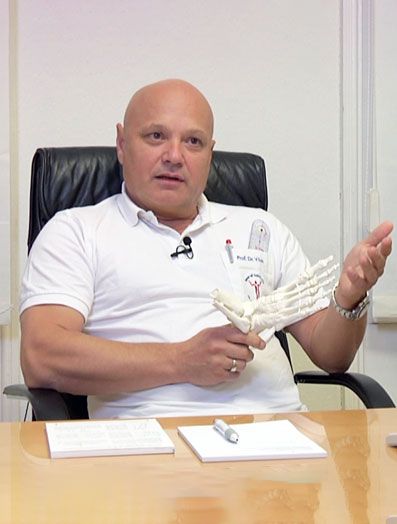Claw Toes
Claw toes, like the hammer toes, are deformed in the proximal intermediate joint but also in the distal intermediate joint. The deformity can be flexible or rigid - and the surgical treatment is done accordingly.
Claw toes are toes bent in both the proximal and the distal intermediate link joint, but additionally exhibit a complete (luxation) or partial dislocation (subluxation) in the basal joint. Claw toes do not reach the ground. They have lost their function during walking (no weight-bearing) and standing (no assistance in maintaining body balance).
Analogous to the hammer toes claw toes can be treated with tendon lenghtenings and bone cuts, all done percutaneously through stab incisions. Only in exceptions wo provide tendon transfers.
About the surgery
Conservative measures do not help here. This deformity is operated.
First, the massively shortened flexor tendons must be lenghtened. Is it possible to stretch the toe, then the proximal joint is straightened and fixed only by tape or exceptionally with a micro screw, similar to a hammertoe treatment. Sometimes additionally the distal intermediate joint also needs to be fixed. In particular ankylosed contortions (rigid dislocation), the metatarsal bone is also shortened slightly, so that the toe can be brought back into a congruent joint position (reduction).
We do not use any drill wires, even for this correction!
Activity can be resumed immediately. Walking is possible immediately after the operation, initially restricted and reduced to only what is necessary, but can be increased from the 2nd week onwards. Normal shoes can be worn after 2 to 4 weeks. In case of comprehensive corrections a swelling of the forefoot for about 3 to 8 weeks can be expected.
Example I:
This foot has a claw toe at the II and III toe.
After surgery, both toes reach the ground, do not cause any more problems in the shoe and can bear weight during walking and running.
Example II:
Left: Claw toes and Splayfoot pain (at the heel, and ball area)
Right: After a joint-preserving shortening of the II, III, IV metatarsal and a toe stretching, the toes are straightened and the pain is gone
Example III:
Dig V. varus superductus or little toe, which is situated above the fourth toe and is oriented upwards. The patient has already underone surgery elsewhere, however with no success.
Left: Prior to correctional surgery: fifth toe is oriented upwards
Right: Post surgery: nice straight toe



